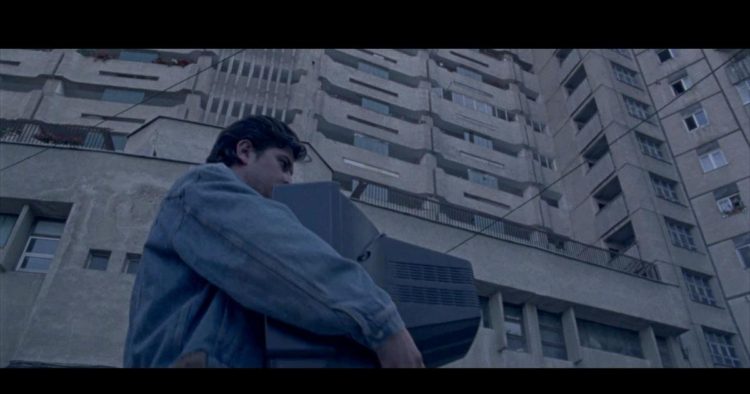September 28, 2020
By Călin Boto
Notes on Pirates II – Prehistories

Screencap from the documentary “Chuck Norris vs Communism”
It’s normal that in Romania, like everywhere else, the debate around movie piracy is a contentious one, and that is because sad stories, like that of Romanian film culture, need heroes. Our heroes are the independent distributors, the small entrepreneurs, who are often humble in their knowledge of film but ready to make middlebrow culture into a trophy. I say middlebrow instead of highbrow, for these distributors are allergic to anything over the top. It is a fact that the murky waters of European cinema flow into Dâmbovița River, and truly brave curating is only kept alive by a few members of festival selection committees, and festivals themselves are in jeopardy.
Establishing a history of audiovisual piracy would make it easier for us to accept its present state. In the end, what is a film pirate? It is a person who opposes certain rules, an outlaw, a subversive trickster, but also a passeur, someone who passes something on. The fact that the sacredness of these rules seems immutable (at least from a moral standpoint) means that the pirate’s activity is a kind of petty thief, engaging in something dirty, disagreeable for respectable citizens. In reality, however, rules are subject to change. Culture is in the air, and movies need to breathe in and out. Was Henri Langlois, the film archive avant-gardist, not doing pirate work when he hid copies of films banned by the Nazi occupation of France? Was he not opposing certain rules? Wasn’t his choice between free access and limited access clear? Oh, of course, he was saving movies from destruction. But a movie that is not seen is a dead movie. If something is not listed in an archive, it does not exist. And, to quote from a 2015 manifesto, the archive is not a storage space. Nor is it a business.
However, we should not appeal to a universal history of audiovisual piracy. Some fragments of Romanian history are absolutely fascinating, and sufficient, I hope, to allow us to turn the page. Perhaps it is from a sense of absurd shame around the fact that piracy is institutionalized in the present that we have avoided talking about institutionalized piracy in the past.
One of the most talked-about phenomena in the history of Romanian piracy was the VHS boom of the ’80s. It was illegal, and it embodied the image (that is, the video image, an already precarious visual medium) bankrupted by the political context. Blurry, grainy images that were endlessly copied; Romanian pirates from the eighties gathered together to see a shadow of the Reagan-era American dream. Chuck Norris, Sylvester Stallone, Arnold Schwarzenegger, those were their pin-ups dripping colonialist testosterone, the toys of an irreconcilable conservatism.
Legendary would be a fitting word to describe these video nights, as all we have left of them are legends. One of these legends goes like this – a translator for the Romanian Television comes, by chance, to illegally dub a few thousand movies on VHS. Evening after evening, her voice would dub freedom, capitalism, and consumerism until the listeners would come to see them as inseparable. And as indispensible, for, the legend continues, this kind of pirated cinephilia spurred the desire for anticommunist revolution. This is, in brief, the narrative that Irina Nistor has been spinning for the past three decades. Fiercely anticommunist, her road to power would be an easy one – as a film critic, promoter, TV and radio host, selector, and mascot of the Oscars, Nistor had all the levers of influence at her disposal. Last year I had the opportunity to undertake a more extensive analysis of the narratives she promotes. Anyway, what I wanted to get at is the idea of piracy as a revolutionary act, as a banner of resistance to oppression, even if just as an idea. And it is an idea that appeals to many people, or, at least, that is how I would explain Nistor’s popularity. This prompts me to return to the mutability of rules, to how the great bravery of some (in keeping with Nistor’s legend) is now the great shame of others, and that is because the rules have changed.

Screencap from the movie “Missing in Action 2: The Beginning” (1985)
Perhaps just as iconic, though less discussed, was a trend of receiving Yugoslav, Bulgarian, Hungarian, and Soviet transmissions through satellite. Like with video nights, there is good reason to believe that, even though this was forbidden, the authorities turned a blind eye. Ion Bogdan Lefter recalls a few oddities from eighties TV piracy – “it was funny that the amplification fittings necessary to get those channels were not just improvised by tech-savvy citizens, but were also produced in licensed workshops, so quasi-officially”; “another thing from the time that was just as absurd: towards the end of the ’80s, right in the center of Bucharest, next to the Intercontinental Hotel, the Bulgarian air travel agency would regularly display the TV program for Bulgarian channels.”[1] Also in Lefter’s text, one can find another fascinating episode: that of public VHS screenings in cultural spaces – in theater buildings, cultural centers, etc., “until the Council for Socialist Culture and Education (the Ministry of Culture of the time) caught wind of this and banned them.”[2] There was a fine line between legality and illegality. Piracy came in through the back door and went out the same way. Sometimes it was free (video nights with friends), other times mediated by a tax (screenings in institutions, video nights for which you had to buy a “ticket”). What’s certain is that there was a “thirst for images,”[3] and copyright law could not hope to taint these waters.
Perhaps the most flagrant episode in the history of institutionalized Romanian piracy took place right in the National Film Archive. The citizens of Bucharest might remember the stupefaction they felt when, seated in their blue seats at the Eforie Cinematheque, The Godfather (d. Francis Ford Coppola, 1972) started playing on the screen in black-and-white. The strange El Topo (d. Alejandro Jodorowsky, 1970), the Technicolor cotton candy that is Viva Las Vegas(d. George Sidney, 1964), L’Histoire d’’dèle H. (d. François Truffaut, 1975) – legend has it that these films were secretly distributed in Romania after the official versions from the distributors were furtively, cheaply, and quickly copied. What better precursor to piracy and the poor image?
Where there’s a will there’s a way – this could be an apt summary for Romanian audiovisual piracy under socialism. Pirates today also need new such ways, the most urgent being free access. Whether it will be granted or not, one thing is certain – piracy is the most exciting thing happening in film at the moment. We only need to wait for new rules, some rules that pirates will not have to struggle against.
Read the first notes on pirates here.
Translated by Rareș Grozea
[1] Călin Dan (ed.), Ex Oriente Lux, Soros Center for Contemporary Arts, 1994, pp. 57-58.
[2] Idem, p. 62.
[3] Idem, p. 58.
POSTED BY
Călin Boto
Călin Boto is the editor-in-chief of the cinema magazine Film Menu and the coordinator of its weekly film club. As a freelancer, he collaborates with several publications and film festivals, includin...



